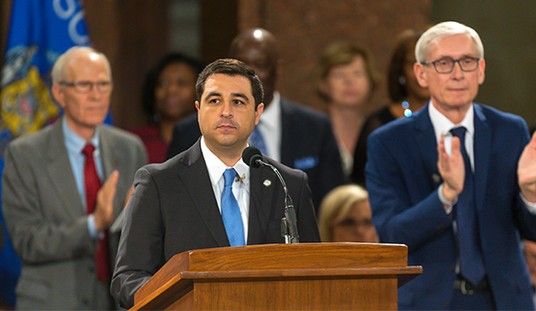Churches across the West are twisting themselves into shapes no apostle would recognize — bending like pretzels to please secular society. They update doctrines, rewrite homilies, and water down long-held beliefs, all in hopes of attracting people who rarely show up anyway. And now the Church of England has chosen its new leader: Dame Sarah Mullally, hailed as a “theological liberal” and celebrated for her progressive stances. But it raises a fair question: does the Archbishop believe in the Christianity she is meant to lead, or only in a softened imitation of it?
Mullally, the first female Archbishop of Canterbury in the church’s 1,400-year history, has openly said, “I would suspect that I would describe my approach to this issue as pro-choice rather than pro-life, although if it were a continuum I would be somewhere along it moving towards pro-life when it relates to my choice and then enabling choice when it related to others.” In other words, she suggests she might personally avoid abortion, but her public stance is firmly pro-choice. Past Archbishops have sometimes spoken with personal reservations about abortion while avoiding a strong public label. Mullally, however, has been more direct — identifying herself as pro-choice while simultaneously noting her personal hesitation.
One might ask: how much can be altered before a Church becomes something else entirely?
The Catholic Church is facing its own test. Consider the recent Chicago controversy, where Senator Dick Durbin (D-Ill.) was set to receive a lifetime award from the Archdiocese despite his decades of support for abortion. After outrage from Catholics, Durbin declined the award. But Pope Leo XIV seized the moment — not to reaffirm the Church’s teaching on the sanctity of life, but to attempt to redefine it. “Someone who says I am against abortion but is in favor of the death penalty is not really pro-life,” Leo declared. He added that rejecting mass migration was equally inconsistent.
Around the same time, he presided over a climate-justice event where he blessed a giant block of ice, sparking ridicule across the Catholic world. Many faithful had hoped that Leo’s papacy would move the Church away from the ambiguity of Francis. Instead, so far, his priorities have closely echoed those of his predecessor. Whether that continuity comes from personnel, persuasion, or simply ideology, the direction looks much the same.
Recommended
Here in America, the Protestant world is no less divided. The United Methodist Church — once the most middle-of-the-road of the mainline denominations — is fracturing. Thousands of congregations have disaffiliated, entire conferences have split, and the denomination is hemorrhaging members. The cause? Years of leadership bending doctrine on sexuality and marriage in the name of inclusion.
Many lifelong Methodists feel betrayed. My own grandparents have watched with dismay as their church chased after secular approval at the expense of long-held beliefs. What they see is what millions of Christians throughout the world see: an institution trying to lure people who will not come, while driving away those it has long relied on.
So, will chasing modern acceptance bring revival — or only hasten the church’s ruin?
Across these traditions — Anglican, Catholic, Methodist — the pattern is the same. Leaders who once spoke as shepherds now sound more like progressive politicians than fidei defensores — defenders of the faith. I don’t pretend to be a theologian; my perspective comes from history, family, and living among Catholics. But you don’t need a seminary degree to notice when bishops and popes abandon the clarity of the Gospel for the talking points of the age.
England is a useful warning for Americans. We often think of Britain as a kind of sibling — culturally close, in some ways maybe a step ahead. And in secularization, it is certainly ahead. For centuries, English Christianity has lived with the precedent that doctrine can be altered to fit politics. That precedent was set by Henry VIII’s break with Rome and later deepened under Cromwell, when Puritan rule tore down much of England’s religious and cultural inheritance. It still shapes the church today.
Meanwhile, Islam — with no interest in moderating itself to suit modern Britain — is expanding in numbers and confidence. Christianity doesn’t survive by altering its convictions to fit the age. Whether churches are doing so to chase new members or simply because leaders themselves hold those views, the result is the same: a faith that looks less like itself with every compromise.
Baseball offers a useful parallel. For more than a century, its appeal lay in how little it changed. Unlike football or basketball, it had no clock, no countdown, no quarterly breaks. It was the one sport where time itself did not rule the game. Fans loved that they could compare Babe Ruth’s season in the 1920s with Aaron Judge’s today and know the game itself had remained the same.
But in recent years, baseball has chipped away at that tradition. A pitch clock was introduced to speed things up. Advertisements were stitched onto sacred jerseys like those of the Yankees and Red Sox. The designated hitter, once confined to one league, spread to both. Even the bases themselves were changed. The league argued these moves would lure new fans. Yet to many lifelong followers, it made the game look less like baseball.
Christianity is facing the same question. How much of the faith’s long-held tenets can be altered to suit modernity before it stops being Christianity? It’s the Ship of Theseus problem: how many beams can you replace before the vessel is no longer the same? At what point does adapting to modernity become abandoning the faith?
Baseball without its traditions isn’t baseball. And Christianity without its tenets is a faith that has lost its compass.


